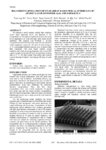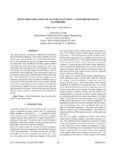Filters: Department: "Electrical & Computer Engineering" School Or College: "College of Engineering" Collection: "ir_uspace"
| Creator | Title | Description | Subject | Date | ||
|---|---|---|---|---|---|---|
| 101 |
 | Myers, Chris J. | Automatic abstraction for synthesis and verification of deterministic timed systems | This paper presents a new approach for synthesis and verification of asynchronous circuits by using abstraction. It attacks the state explosion problem by avoiding the generation of a flat state space for the whole design. Instead, it breaks the design into sub-blocks and conducts synthesis and veri... | 2000 | |
| 102 |
 | Stevens, Kenneth | Automatic addition of reset in asynchronous sequential control circuits | Asynchronous finite state machines (AFSMs) usually require initialization to place them in a desired starting state. This normally occurs by toggling a reset signal upon power-up. This paper presents an algorithm to automatically generate power-up reset circuitry thus adding reset to an AFSM after t... | 2014-01-01 | |
| 103 |
 | Tasdizen, Tolga; Whitaker, Ross T. | Automatic assembly of TEM mosaics and mosaic stacks using phase correlation | This paper discusses automatic Transmission Electron Microscopy (TEM) image registration, TEM slice assembly via tile mosaicking, and TEM volume assembly via slice to slice registration. Several algorithms are presented, including an algorithm for mosaic layout of an unordered set of tiles, an algor... | 2007 | |
| 104 |
 | Tasdizen, Tolga; Foster, Norman L. | Automatic classification of alzheimer's desease vs. frontotemporal dementia: a spatial decision tree aprroach with FDG-PET | We introduce a novel approach for the automatic classification of FDG-PET scans of subjects with Alzheimers Disease (AD) and Frontotemporal dementia (FTD). Unlike previous work in the literature which focuses on principal component analysis and predefined regions of interest, we propose the combined... | 2008 | |
| 105 |
 | Myers, Chris J. | Automatic derivation of timing constraints by failure analyis | Abstract. This work proposes a technique to automatically obtain timing constraints for a given timed circuit to operate correctly. A designated set of delay parameters of a circuit are first set to sufficiently large bounds, and verification runs followed by failure analysis are repeated. Each ver... | 2002 | |
| 106 |
 | Tasdizen, Tolga | Automatic markup of neural cell membranes using boosted decision stumps | To better understand the central nervous system, neurobiologists need to reconstruct the underlying neural circuitry from electron microscopy images. One of the necessary tasks is to segment the individual neurons. For this purpose, we propose a supervised learning approach to detect the cell membra... | 2009 | |
| 107 |
 | Stevens, Kenneth; Davis, Alan L. | Automatic synthesis of fast compact self-timed control circuits | We present a tool called MEAT which has been designed to automatically synthesize transistor level. CMOS, self-timed control circuits. MEAT has been used to specify and synthesize self-timed circuits for a fully self-timed 300,000 transistor communication coprocessor. The design is specified using f... | 1993 | |
| 108 |
 | Stevens, Kenneth | Automatic synthesis of fast, compact self-timed control | An automated synthesis tool, called the Most Excellent Asynchronous Tool, or MEAT is presented. This tool has been used to specify and synthesize self-timed circuits for a fully self-timed 300,000 transistor communication co-processor. The Specification is done with stylized state diagrams. This is ... | 1992 | |
| 109 |
 | Stevens, Kenneth; Myers, Chris J. | Average-case optimized technology mapping of one-hot domino circuits | This paper presents a technology mapping technique for optimizing the average-case delay of asynchronous combinational circuits implemented using domino logic and one-hot encoded outputs. The technique minimizes the critical path for common input patterns at the possible expense of making less commo... | 1998 | |
| 110 |
 | Myers, Chris J.; Stevens, Kenneth | Average-case optimized technology mapping of one-hot domino circuits* | This paper presents a technology mapping technique for optimizing the average-case delay of asynchronous combinational circuits implemented using domino logic and one-hot encoded outputs. The technique minimizes the critical path for common input patterns at the possible expense of making less commo... | 1998 | |
| 111 |
 | Stringfellow, Gerald B. | Bandgap control of GaInP using Sb as a surfactant | The use of surfactants to control specific aspects of the vapor-phase epitaxial growth process is beginning to be studied for both the elemental and III/V semiconductors. To date, most reported surfactant effects for semiconductors relate to the morphology of the growing films. However, semicondu... | Band-gap energy; Growth process; Epitaxial growth | 1999-09-27 |
| 112 |
 | Stevens, Kenneth | Bandwidth optimization in asynchronous NoCs by customizing link wire length | The bandwidth requirement for each link on a network-on-chip (NoC) may differ based on topology and traffic properties of the IP cores. Available bandwidth on an asynchronous NoC link will also vary depending on the wire length between sender and receiver. We explore the benefit to NoC performance ... | 2010 | |
| 113 |
 | Mastrangelo, Carlos H. | Batch fabrication of flowable colorimetric pressure sensing particles via surface micromachining | The batch fabrication and test of artificial optical resonator slab-type micro particles (14 μm diameter, 0.7 μm gap) is presented as a means to map absolute pressure within microscopic environments. The pressure-sensing particles consist of a semi-transparent elastic polysilicon shell enclosi... | 2010 | |
| 114 |
 | Stringfellow, Gerald B. | Bi surfactant control of ordering and surface structure in GaInP grown by organometallic vapor phase epitaxy | Studies the effect of the surfactant bismuth on the ordering and surface structure in GaInP layers grown by organometallic vapor phase epitaxy. Disordering caused by the addition of bismuth during growth; Changes in surface structure occurring with the disordering. | Thin films, Multilayered; Bismuth | 2000 |
| 115 |
 | Stringfellow, Gerald B.; Shurtleff, James Kevin | Bi surfactant effects on ordering in GaInP grown by organometallic vapor-phase epitaxy | The effect of the isoelectronic surfactant Bi on surface structure and ordering has been studied for GaInP semiconductor alloys grown by organometallic vapor-phase epitaxy. A small amount of Bi trimethylbismuth added during growth is found to result in disordering for layers grown using conditions t... | Surfactant; Semiconductors; Trimethylbismuth | 2000 |
| 116 |
 | Rieth, Loren W | Bi-layer encapsulation of Utah array based nerual interfaces by atomic layer deposited Al2O3 and parylene C | We present a novel coating method that combines atomic layer deposited Al2O3 and Parylene C for encapsulation of biomedical implantable devices, focusing on its application on Utah electrode array based neural interfaces. The alumina and Parylene C bi-layer encapsulated wired Utah electrode array sh... | 2013-01-01 | |
| 117 |
 | Harrison, Reid R. | Biologically inspired analog IC for visual collision detection | We have designed and tested a single-chip analog VLSI sensor that detects imminent collisions by measuring radially expanding optic flow. The design of the chip is based on a model proposed to explain leg-extension behavior in flies during landing approaches. We evaluated a detailed version of thi... | Visual collision detection; VLSI | 2005-11 |
| 118 |
 | Furse, Cynthia M. | Biomedical telemetry: today's opportunities and challenges | Biomedical telemetry is used today to communication with cardiac devices, insulin pumps, and a few other implantable devices that are on the order of 1-2" in diameter. Future systems promise advanced communication with cardiac, optical, neurological and auditory devices that are on the order of a ce... | 2009-03 | |
| 119 |
 | Mathews, V. John | Blind identification of bilinear systems | Abstract-This paper is concerned with the blind identification of a class of bilinear systems excited by non-Gaussian higher order white noise. The matrix of coefficients of mixed input-output terms of the bilinear system model is assumed to be triangular in this work. Under the additional assumptio... | 2003 | |
| 120 |
 | Mathews, V. John | Blind identification of bilinear systems | Abstract This paper is concerned with the blind identification of bilinear systems excited by higher-order white noise. Unlike prior work that restricted the bilinear system model to simple forms and required the excitation to be Gaussian distributed, the results of this paper are applicable to a m... | 2001 | |
| 121 |
 | Mathews, V. John | Blind identification of QAM signals using a likelihood-based algorithm | This paper presents a method for automatically identifying different QAM modulations. This method identifies the modulation type as the hypothesis for which the likelihood function of the amplitudes of the received signal is the maximum. The derivation of the likelihood functions assumes additive wh... | 2013-01-01 | |
| 122 |
 | Tasdizen, Tolga | Boundary estimation from intensity/color images with algebraic curve models | A new concept and algorithm are presented for noniterative robust estimation of piecewise smooth curves of maximal edge strength in small image windows - typically 8 x 8 to 32 x 32. This boundary-estimation algorithm has the nice properties that it uses all the data in the window and thus can find l... | 2000 | |
| 123 |
 | Harrison, Reid R. | Brain-machine interface, unplugged | In experiments and even limited human clinical trials, electrode arrays implanted on the brain's surface have given monkeys and humans the ability to move objects with their thoughts. The experiments are proof that brain-computer interfaces could improve the lives of severely paralyzed people. But... | Wireless neural implants; Brain-computer interface | 2009-01-01 |
| 124 |
 | Furse, Cynthia M. | Broadband and multiband antenna design using the genetic algorithm to create amorphous shapes using ellipses | A method is demonstrated for generating compact, broadband and multiband antennas using ellipses to create new amorphous shapes with greater bandwidth and less return loss that previously demonstrated. Four designs are presented including a tri-band patch antenna optimized for low reflection loss a... | Broadband antenna design; Multiband antenna design; Ellipses | 2006-10 |
| 125 |
 | Stevens, Kenneth | CA-BIST for asynchronous circuits: a case study on the RAPPID asynchronous instruction length decoder | This paper presents a case study in low-cost noninvasive Built-In Self Test (BIST) for RAPPID, a largescale 120,000-transistor asynchronous version of the Pentium® Pro Instruction Length Decoder, which runs at 3.6 GHz. RAPPID uses a synchronous 0.25 micron CMOS library for static and domino lo... | 2000 |
